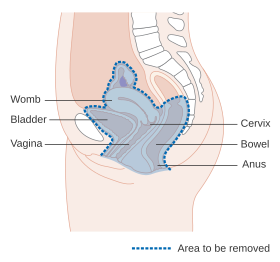Pelvic exenteration
| Pelvic exenteration | |
|---|---|
| Intervention | |

Diagram showing the area removed in a pelvic exenteration in a female
|
|
| ICD-9-CM | 68.8 |
| MeSH | D010385 |
Pelvic exenteration (or pelvic evisceration) is a radical surgical treatment that removes all organs from a person's pelvic cavity. The urinary bladder, urethra, rectum, and anus are removed.
The procedure leaves the person with a permanent colostomy and urinary diversion. In women, the vagina, cervix, uterus, fallopian tubes, ovaries, and in some cases the vulva are removed. In men, the prostate is removed.
Pelvic exenteration is most commonly used in cases of very advanced or recurrent cancer, in which less radical surgical options are not technically possible or would not be sufficient to remove all the tumor. This procedure is performed for many types of cancer including genitourinary and colorectal cancers.
Recent literature has shown that pelvic exenteration can provide long-term survival for patients with locally advanced primary rectal carcinoma. The 5-year survival rate of patients undergoing pelvic exenteration following complete resection of disease was 59.3%. A number of factors have been shown to influence the survival rates following a pelvic exenteration procedure. These include age, the presence of metastatic disease, lymph node status, circumferential resection margin, local recurrence of disease, and the need for neoadjuvant therapy.
After pelvic exenteration, many patients will have perineal hernia, often without symptoms, but only 3–10% will have perineal hernia requiring surgical repair.
The procedure was first described by Alexander Brunschwig in 1948.
...
Wikipedia
